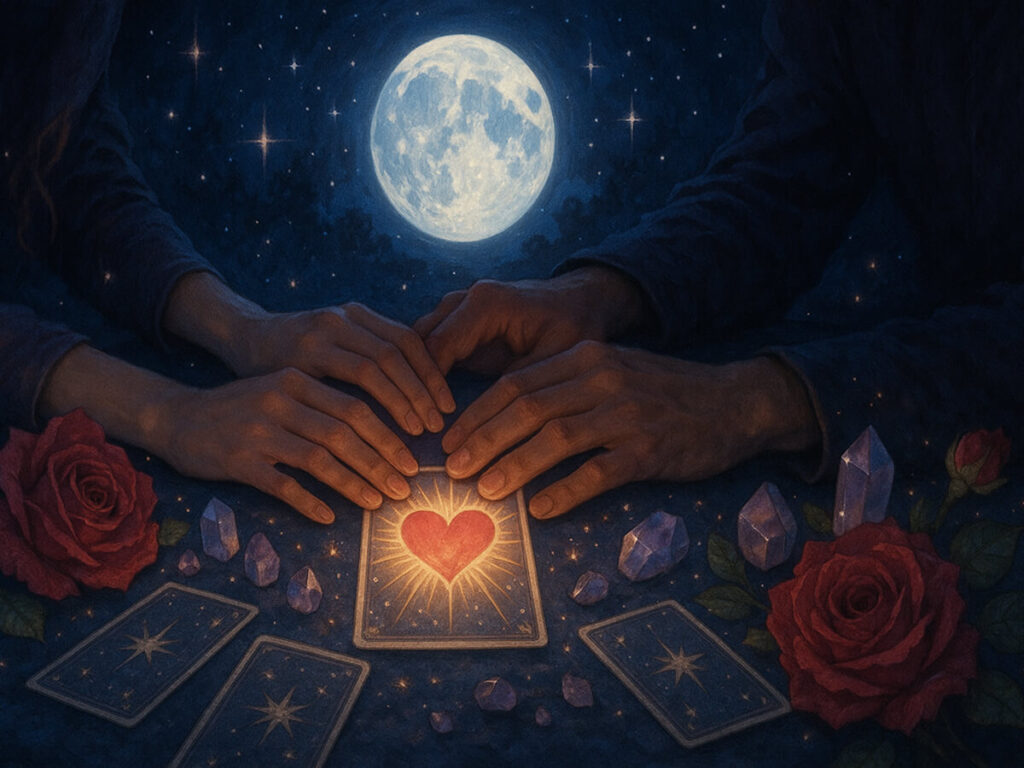Tarot for Love & Relationships Guide for 2025


Table of Contents
Hello, beautiful souls, and welcome. I’m Miranda Starr, and for years, I’ve had the privilege of guiding seekers like you through the intricate tapestry of life using the wisdom of tarot. One area where the cards consistently offer profound clarity and gentle guidance is the realm of love and relationships. It’s a landscape filled with soaring joys, confusing crossroads, and sometimes, heartbreaking lows. We all yearn for connection, understanding, and partnerships that nourish our spirits, but navigating this path isn’t always straightforward.
Why do so many of us turn to tarot when our hearts are involved? It’s not about demanding predictions or seeking definitive answers carved in stone. Instead, tarot acts as a mirror, reflecting our inner truths, hidden desires, and the subtle energies shaping our connections. It’s a powerful tool for self-reflection, helping us understand the dynamics at play, uncover subconscious patterns, and illuminate the choices that lead towards greater fulfillment, whether single, coupled, or navigating complex situations. When we approach a love reading, we aren’t asking the cards to dictate our future; we’re inviting a conversation with our own intuition and the universe’s subtle whispers.
To truly benefit from this conversation, it helps to come with an open mind and heart. Rather than asking broad, passive questions like “Will I find love?”, frame your inquiries constructively. Think about what you truly want to understand: “What patterns might be blocking me from attracting a healthy relationship?” or “How can my partner and I improve our communication?” or “What do I need to focus on for my own emotional healing right now?” These kinds of questions empower you to take an active role in your love life, using the tarot’s insights as a compass rather than a rigid map. Join me as we explore how these beautiful cards can illuminate your path to deeper understanding and more fulfilling connections.
Whispers of the Heart: Key Tarot Cards in Love Readings
Within the seventy-eight cards of a tarot deck lies a universe of symbolism, particularly potent when exploring matters of the heart. Understanding the core messages of certain cards can provide invaluable insights into your relationships and romantic journey. The deck is broadly divided into the Major Arcana, representing significant life lessons and archetypal energies, and the Minor Arcana, reflecting the day-to-day situations and experiences that shape our lives. In love readings, the Major Arcana often points to pivotal moments, deep soul connections, or overarching themes influencing your romantic path, while the Minor Arcana details the specific feelings, actions, challenges, and joys encountered along the way.
Let’s delve into some of the most significant players from the Major Arcana when love is the question. The Lovers card, perhaps unsurprisingly, is paramount. It speaks of harmonious unions, important choices related to relationships, and the power of connection built on shared values and authentic attraction. It signifies a deep bond and mutual respect. Following closely is The Empress, embodying nurturing energy, sensuality, abundance, and fertility. In a love context, she suggests a relationship ripe with affection, comfort, and potential growth, perhaps even indicating pregnancy or the birth of new creative projects within the partnership. Her counterpart, The Emperor, brings structure, stability, and protection. He can represent a committed, long-term partner or the need for clear boundaries and established roles within a relationship for it to feel secure. The Hierophant often points towards tradition, commitment, and shared belief systems. This card can signify marriage, conventional relationships, or seeking guidance from established wisdom or institutions regarding your partnership. While these are prominent, other Major Arcana cards like Strength (inner courage, compassion in relating), The Star (hope, healing, inspiration after difficult times), The Sun (joy, vitality, clarity, success in love), and The World (completion, fulfillment, successful integration) also carry significant weight, often marking major milestones or energetic shifts in one’s love life.
Turning to the Minor Arcana, the suit of Cups is most directly associated with emotions, feelings, intuition, and relationships, making it central to love readings. The Ace of Cups heralds new emotional beginnings – the potential for new love, deepening affection, or renewed emotional connection. The Two of Cups is a classic card of partnership, harmony, mutual attraction, and the promising start of a balanced union. Celebration and social connection arrive with the Three of Cups, sometimes indicating group happiness or, occasionally, the presence of a third party. A period of introspection, apathy, or even dissatisfaction might be signaled by the Four of Cups, urging you to look within or recognize overlooked opportunities. The Five of Cups often points to sadness, loss, or regret, focusing on what’s been spilled rather than what remains – a call to shift perspective. Nostalgia, happy memories, and connections from the past (sometimes the return of an old flame) are themes of the Six of Cups. Be wary of illusion or too many choices with the Seven of Cups, which speaks of fantasy and the need for clarity. The Eight of Cups signifies walking away, abandoning something emotionally unfulfilling to seek deeper meaning elsewhere. Emotional contentment and wishes fulfilled shine through the Nine of Cups, a card of satisfaction and pleasure. Finally, the Ten of Cups represents ultimate emotional fulfillment, happy family life, lasting harmony, and ‘happily ever after’ energy. While Cups are primary, cards from other suits also play vital roles. The Four of Wands often signifies celebrations, stability, harmony, and milestones like engagements or moving in together. The Ten of Pentacles speaks to long-term security, family legacies, and the material stability of a committed partnership.
A brief note on reversed cards in love readings: Don’t panic! A reversed card isn’t necessarily negative. It often indicates that the card’s energy is blocked, internalized, delayed, or needs closer examination. For instance, a reversed Lovers might suggest inner conflict about a relationship or disharmony. A reversed Ace of Cups could mean emotional blockage or suppressing feelings. It’s an invitation to look deeper into the nuances of the situation and your internal state regarding the relationship.
Mapping Your Heart: Popular Tarot Spreads for Love
While individual cards offer potent messages, laying them out in a specific pattern, known as a tarot spread, provides structure and context, allowing for a more nuanced and focused reading. Spreads act like maps for your inquiry, assigning specific meanings or questions to each card position. This helps to untangle complex situations and reveal the interplay of different energies surrounding your love life. There are countless spreads available, ranging from simple three-card pulls for quick insights to intricate layouts designed for deep dives into specific relationship dynamics.
Love spreads often fall into several categories, addressing different needs. Some are designed for a general relationship check-in, assessing the current energy and health of a partnership. Others focus on compatibility, exploring how well suited two people might be. Specific spreads exist to help troubleshoot problems or navigate challenges like conflict or reconciliation. For those seeking romance, there are spreads aimed at finding new love and attracting a suitable partner. And importantly, many spreads focus on self-love, recognizing that our relationship with ourselves is the foundation for all other connections.
A simple yet powerful spread for quick guidance is the Three-Card Spread. You can adapt the positions to your specific question. For instance: 1. Position 1: The Situation: Represents the current energy or core issue in your love life. 2. Position 2: The Action/ Challenge: Suggests a course of action, an obstacle to overcome, or something needing attention. 3. Position 3: The Outcome/Guidance: Offers insight into the potential outcome if the current path continues or provides guidance on the best way forward. Alternatively, for a relationship focus, the positions could be: 1. You, 2. Your Partner, 3. The Relationship Dynamic.
For a deeper look into compatibility, consider the Compatibility Spread (often using 7 cards), which explores the connection from multiple angles: 1. Your Needs/Desires: What you seek in a relationship. 2. Partner’s Needs/Desires: What your potential or current partner seeks. 3. Key Differences: Areas where your needs or approaches diverge. 4. Shared Values/Interests: Common ground that strengthens the bond. 5. Emotional Compatibility: How your feelings and emotional expressions align. 6. Physical/Lifestyle Compatibility: Alignment in physical attraction, daily habits, or life goals. 7. Overall Compatibility/Potential: The overarching energy and potential of the connection.
If you are single and looking to attract love, the Magnetic to Love Spread (also often 7 cards) can be illuminating: 1. Limiting Beliefs: What subconscious beliefs might be hindering love? 2. What to Release: Energies or patterns that need to be let go. 3. Manifestation Method: The best way for you to actively attract love. 4. Opening Your Heart: How to become more receptive to connection. 5. Current Blockages: Immediate obstacles standing in your way. 6. Increasing Magnetism: Actions to enhance your attractive energy. 7. Direction: The path forward towards finding love.
Finally, never underestimate the power of turning the cards inward. Spreads like the Honor Yourself Spread or the Love Yourself First Spread guide you to explore your relationship with yourself, identify your worth, understand your needs, and cultivate the self-compassion that makes all relationships healthier. Choosing the right spread depends on your specific question and the depth of insight you seek, but each offers a unique lens through which to view the landscape of your heart.
Listening to the Cards: How to Interpret Your Love Reading
Receiving guidance from tarot is less about deciphering cryptic codes and more about engaging in a profound conversation with your own intuition, using the cards as prompts and symbols. While understanding the traditional meanings of each card, as we explored earlier, provides a crucial foundation, true interpretation goes beyond reciting keywords. It involves weaving together the messages of individual cards, considering their positions within the spread, and listening intently to the feelings and insights that arise within you during the reading.
One of the most common pitfalls for beginners is looking at each card in isolation. Instead, try to see the spread as a narrative, a story unfolding before you. How do the cards interact? Does a challenging card appear next to one offering hope or a solution? Is there a progression from one card to the next, suggesting a sequence of events or evolving feelings? For example, seeing the Five of Cups (loss, regret) followed by the Ace of Cups (new emotional beginnings) tells a very different story than the Five of Cups followed by the Eight of Cups (walking away). Look for the overarching themes. Are multiple cards from the Cups suit appearing, emphasizing the emotional core of the situation? Are Pentacles dominant, suggesting practical or security concerns are paramount in the relationship? Recurring numbers or court card ranks can also offer clues about cycles or specific personality types involved.
The position a card occupies within your chosen spread is critical. A card’s meaning is always filtered through the lens of the question assigned to its position. The Empress in a position representing “Your Strengths in the Relationship” carries a different nuance than The Empress appearing in the “Obstacles” position (perhaps suggesting smothering tendencies or over-reliance on comfort). Always refer back to the meaning of the position as you interpret the card placed there. It provides the specific context needed to understand the card’s relevance to your inquiry.
Crucially, pay attention to your own inner responses. Tarot is a deeply intuitive practice. As you gaze at the cards, what feelings surface? Do certain images trigger memories or associations? Does a particular interpretation resonate strongly, even if it’s not the most obvious one? Trust these intuitive hits. Sometimes, the cards speak directly to our subconscious, bypassing the analytical mind to deliver the message we most need to hear. Don’t dismiss a gut feeling or a sudden flash of insight; it’s often an integral part of the reading.
To deepen your understanding and track your progress, consider incorporating practical habits into your tarot practice. Journaling about your readings is invaluable. Write down the spread used, the cards drawn, your initial interpretations, and any feelings or thoughts that came up. Taking a photo of the spread can also be helpful for later reflection. It’s often surprising how insights continue to unfold days or even weeks after the initial reading. Revisiting your notes allows you to see patterns, track developments, and appreciate the accuracy of your intuition over time.
Finally, it’s vital to approach tarot interpretation with ethical awareness, especially concerning love. Remember, the cards offer guidance, perspective, and potential pathways – they do not dictate a fixed or unchangeable future. Free will always plays a role. Use the insights gained not to passively wait for predictions to come true, but to make empowered choices. Focus on what you can control: your actions, your reactions, your healing, and your growth. Tarot’s true power in love readings lies in its ability to foster self-awareness, illuminate relationship dynamics, and empower you to create the fulfilling connections you desire, starting with the relationship you have with yourself.
The Greatest Romance: Using Tarot for Self-Love
While tarot is often sought for guidance on romantic partnerships, perhaps its most profound application in the realm of the heart is turning its wisdom inward, towards cultivating the greatest romance of all: the one we have with ourselves. The quality of our external relationships is invariably a reflection of our internal landscape. A strong foundation of self-love, self-awareness, and self-compassion is essential for attracting and maintaining healthy, fulfilling connections with others. Without it, we may unconsciously repeat patterns, accept less than we deserve, or struggle to set healthy boundaries. Tarot can be an incredibly insightful and supportive companion on this journey of self-discovery and nurturing self-worth.
How exactly can these cards help us fall more deeply in love with ourselves? Firstly, tarot acts as a mirror to our subconscious, bringing hidden beliefs and patterns into conscious awareness. Through carefully chosen questions and spreads focused on self-perception, we can uncover limiting beliefs we hold about our lovability, our worthiness, or our capacity for connection. Cards like the reversed Nine of Cups might highlight where we seek external validation instead of cultivating inner contentment, or the Five of Pentacles could point to feelings of lack or exclusion that impact how we approach relationships. Recognizing these patterns is the first step towards healing and rewriting them.
Specific tarot spreads are designed explicitly for this inner work. The Love Yourself First Spread, for example, might ask: 1. What makes me wonderful? 2. What special gift do I share with the world? 3. What holds me back from true happiness? 4. What block needs removing now? 5. How can I best show myself love today? Similarly, a Self-Care Spread could explore: 1. What does my inner child need? 2. What does my future self need me to do now? 3. How can I treat myself with kindness right now? 4. What will restore and refresh my spirit? 5. What is my self-care mantra? Engaging with these spreads regularly allows for deep introspection, helping you identify your authentic needs, celebrate your strengths, and pinpoint areas requiring gentle attention and healing.
Beyond identifying limiting beliefs, tarot can actively help in releasing them. By drawing cards on questions like “What energy do I need to embrace to release this belief?” or “What is the first step towards embodying greater self-worth?”, you receive actionable guidance. The cards might suggest embracing the courage of Strength, the hope of The Star, or the boundary-setting clarity of the Queen of Swords. Furthermore, tarot is a powerful tool for setting intentions. You can use the cards to clarify your intentions for self-care, for attracting relationships that honor your worth, or for cultivating specific qualities like confidence or authenticity within yourself. Pulling a card to represent your intention for the day or week can serve as a potent visual reminder and energetic anchor. Ultimately, using tarot for self-love isn’t about navel-gazing; it’s about actively participating in your own emotional well-being, building resilience, and recognizing that you are inherently worthy of love and belonging, starting from within.
Embracing Your Love Story with Tarot
Navigating the complexities of love and relationships can feel like sailing vast, unpredictable oceans. Yet, within the symbolic language of tarot, we find a powerful lighthouse, offering guidance, clarity, and the illumination needed to chart a more conscious and fulfilling course. As we’ve explored, tarot isn’t about seeking rigid predictions or surrendering your power to fate. Instead, it’s a dynamic tool for profound self-reflection, helping you understand the undercurrents of your connections, recognize recurring patterns, and connect deeply with your own intuition. Whether you’re seeking to understand a current partnership, attract new love, or cultivate a deeper relationship with yourself, the cards offer wisdom and perspective.
Remember, the true magic lies not just in the cards themselves, but in the conversations they spark within you. They mirror your inner truths and empower you to make choices aligned with your heart’s deepest desires. Approach your readings with curiosity, openness, and self-compassion. Use the insights gained as stepping stones for growth, communication, and healing. Your love story is uniquely yours to write, and tarot can be a beautiful, insightful companion as you embrace every chapter with greater awareness and intention. May your journey be filled with love, understanding, and the courage to connect authentically, starting with the beautiful soul reading these words.
Frequently Asked Questions
As you delve into using tarot for guidance on love and relationships, certain questions naturally arise. Here are answers to some of the most common inquiries I encounter:
Can tarot predict when I will find love?
Tarot is more adept at revealing energies, potentials, and internal/external factors influencing your love life rather than providing exact dates or timelines. While some cards or combinations might suggest opportune moments or periods of readiness (like the Ace of Cups indicating new beginnings), timing in tarot is often fluid. A reading might show you how to align yourself to attract love or what obstacles need clearing first, which is arguably more empowering than a fixed date. Focus on the guidance offered for action and self-development, and trust that timing often unfolds naturally as you become ready.
Can tarot tell me if my partner is cheating?
This is a sensitive area where ethical considerations are paramount. While cards like the Three of Cups reversed or the Seven of Swords can sometimes hint at deception or third- party situations, tarot should not be used as a definitive lie detector or a tool for accusation. A reading might reflect feelings of mistrust, communication breakdowns, or external distractions within the relationship, but interpreting these as concrete proof of infidelity is unwise and potentially damaging. If you have serious concerns, it’s always best to address them through direct, honest communication with your partner, perhaps supplemented by professional counseling, rather than relying solely on a card reading.
How often should I do love readings?
There’s no single right answer, but generally, avoid doing readings on the same question obsessively, especially if you’re feeling anxious or seeking a specific outcome. Constant readings can muddy the waters and increase anxiety. It’s often more beneficial to perform a reading, reflect on its insights, take inspired action, and then allow some time for energies to shift before revisiting the question. For general check-ins or self- reflection, monthly or seasonally might feel right. For specific situations, read as needed, but give the guidance time to integrate.
What if I get a scary card in a love reading?
Cards like The Tower, Death, or the Ten of Swords can seem alarming, especially in a love context. Remember, these cards rarely signify literal physical events. The Tower often represents sudden, necessary change or upheaval that clears the way for something new. Death usually signifies an ending, transformation, and rebirth – perhaps the end of a relationship phase or an old way of relating, making way for renewal. The Ten of Swords can indicate a painful ending, hitting rock bottom, but also the point where things can only get better. View these cards as signals of significant transformation or necessary endings, which, while potentially difficult, ultimately serve your growth.
Can I do a love reading about someone specific without their permission?
Ethically, it’s generally advised against doing readings focused solely on prying into another person’s private thoughts or feelings without their consent. It can be seen as an energetic intrusion. However, you can do readings focused on your relationship with that person, your feelings, your perspective, and the dynamics between you. Frame questions around your role, your understanding, and your path forward concerning the connection (e.g., “What do I need to understand about my connection with X?” or “How can I best navigate my interactions with X?”). Keep the focus on your own journey and insights.






